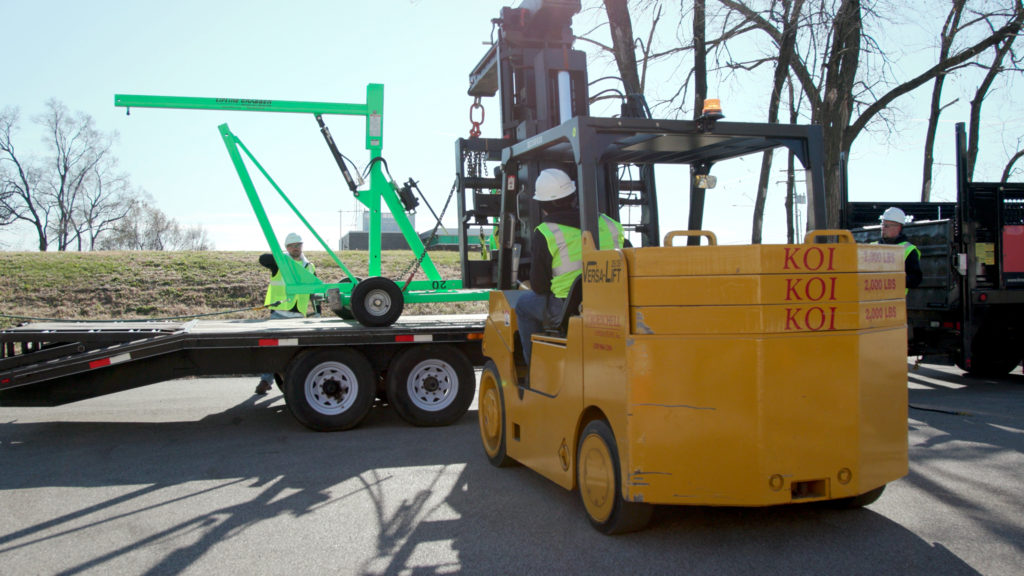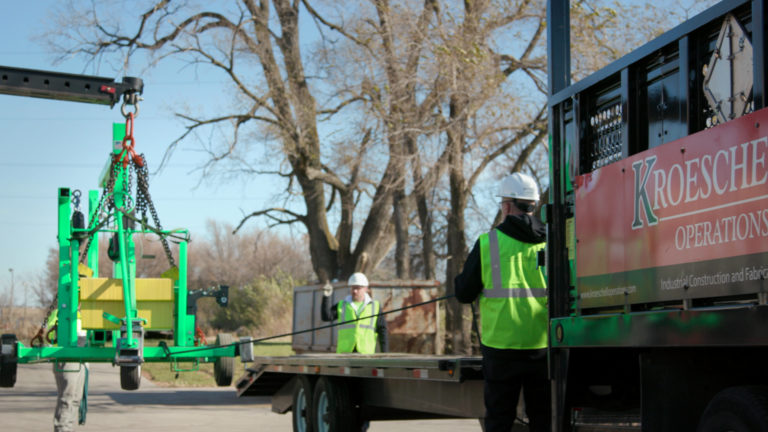The Complete Guide to Machine Moves
Business is booming. You’ve squeezed every square inch out of your current facility, are running three full-time shifts around the clock, and are keeping production lines going 24/7. It’s time to relocate to a new campus with room to grow and expand. As exciting as that can be for your organization, the effort probably requires moving one or many large machines, which can be complex and potentially dangerous.
This guide will help you successfully plan and execute the daunting task of machine moves, whether it be for relocation, upgrade, return, reconfiguration or expansion.
Machine Moves: What Are Your Risks?
Moving heavy equipment can be challenging and complex. A company that embarks on this effort haphazardly takes on a great deal of risk to its employees and overall business. Consider the following common problems that may occur during a machine move:
- Safety. Employee and contractor safety should be at the top of your list when it comes to moving heavy equipment. Not only can physically moving industrial machinery be dangerous but reinstalling it incorrectly could cause injury or even death to operators at the new location. Be sure equipment is re-installed properly.
- Asset Protection. Most large industrial equipment is extremely costly so damages incurred during a machine move can have significant financial consequences to the business.
- Downtime. Any business that runs production lines knows the cost of downtime when equipment fails. Those costs can multiply exponentially if a machine move takes longer than expected or results in production problems.
- Reputation Management. Today’s consumer not only has high expectations when it comes to delivery and service but also wants to work with responsible organizations. Significant order delays, cancellations, or media reports about on-site accidents can negatively affect your reputation.

Tools for a Machine Move
Fortunately, modern tools and moving equipment can go a long way to help you complete your machine move successfully. Here are common heavy-lifting tools and situations where they perform their best:
Forklifts
Although forklifts are most commonly used for moving goods around warehouses, this industrial vehicle can move parts of large equipment as well. The battery or combustion engine-powered forked platform can be easily raised and lowered to move items easily.
General warehouses use one-ton capacity forklifts while businesses moving shipping containers may require a 50-ton forklift. Specialized, compact heavy forklifts can lift upwards of 50,000 pounds on solid ground and manage tight spaces with low headroom inside a facility. Forklifts can also transport heavy loads over long distances, and operators can use side shifters to move loads and tilt the mast to prevent loads from sliding.
Machine Skates
Machine skates allow even weight distribution of heavy equipment that must be moved and are engineered to function on both smooth and uneven flooring. Available in many different designs, machine skates can be customized to handle your unique equipment safely.
Factors such as equipment weight and load size will determine how many skates are needed, but three to six skates are common. Other tools such as toe or compact jacks may be required to lift the equipment high enough to position machine skates properly. The number of individuals required to move the equipment will depend on its weight, the flooring type, and surrounding environment.
If you need to move heavy equipment linearly, machine skates can be a great solution that offers both safety and stability. To turn a load on machine skates, you’ll need to create a three-point load system.
Helicopter
Using a helicopter can be beneficial in areas where cranes cannot operate easily to move machinery. Because helicopters have large windows and the ability to turn 360 degrees, they can help place and maneuver equipment more accurately, especially when placement might be on a rooftop or in an open area. They can also move equipment to areas with fewer access points since they come in from above, potentially shortening delivery times.
Roller Skids
Roller skids operate somewhat like machine skates, but they utilize elongated wheels. As one of the most flexible tools, roller skids can be an economical and efficient way to move equipment weighing between 2,000 pounds and 120,000 pounds. They often have swiveling ability that lets you easily change direction during the move, which is particularly helpful in navigating corners, inclines or small spaces.
Toe Jacks
A toe jack or floor jack is used to lift equipment with extremely low or high clearances and are designed to manage a wide range of weight capacities. Often using a hydraulic pump, toe jacks allow you to maneuver machinery more easily onto machine skates.
How do you choose a professional machine mover?
If you haven’t had to move heavy equipment before, it can be daunting to know where to find the best help. The move will likely be expensive and involve some risk to your business. Below are some guidelines to help you make the best decision.
What questions should you ask?
It goes without saying that interviewing several industrial equipment movers would be in order to compare experience, prices, and services for your particular job. Here are some questions that you may want to include during the selection process:
- How long have you been in business? Although longevity isn’t the most important factor, a company with years of experience has history and potentially more credibility than a newer organization.
- How many moves have you completed? Like the first question, this can help you evaluate the expertise of the company.
- Are you certified, insured, and licensed? Be sure your selected company is properly licensed and credentialed to handle your industrial move. Learn about insurance coverage, especially if you’re moving very expensive equipment.
- Can you provide an in-person written estimate? Machine moves are too large to rely on oral agreements. Get everything in writing before beginning your move.
- Who will be in charge of my move and how much experience does that individual have? Having a point person that you trust will be critical in your moving effort. The project manager should have a great deal of experience and orchestrate the project from planning to completion.
- What is your travel time and how is it billed? If it will take time to move between your old location and new location, industrial moving companies will bill for the time it takes to arrive at the initial location and return from the final one. That distance and time can affect your final cost.
- What was your most difficult move and how did you succeed? This question can help gauge the honesty and transparency of the company you’re evaluating, as well as its staff’s problem-solving ability. Even with a great deal of experience, problems are likely to arise and how your movers will handle that is important.
- What extra services do you offer? Some equipment movers may offer additional services to help expedite your move. Now is a good time to explore those services.
- Do you offer discounts? While the final bill will be a significant business expense, be sure to ask if your potential moving companies offer any special discounts.
- How are payments handled? Reputable moving companies will expect payment once the machines have been delivered, not before work is completed. Be sure to plan on inspecting the equipment at the point of delivery so that problems or damages can be documented immediately.
When do you hire a professional vs. doing it yourself?
This is the age-old question when it comes to any type of move. However, in the case of moving industrial equipment, doing it yourself when you lack experience can be extremely costly and potentially very dangerous.
The only situation where it makes sense to do it yourself is if you are intimately familiar with the machine you are moving and are experienced in the equipment and tools that must be used to complete the project safely, correctly, and efficiently. If you or your internal team have that level of expertise, it makes sense to relocate your machinery yourself.
In the majority of cases, it is well worth the expense of paying a professional to complete the machine move for you. Professional industrial movers with years of experience have a proven plan, understand safety precautions, can anticipate potential problems, and are being paid to be experts in this area. They will help you complete the project safely and cost-effectively.
What can a professional do that can’t be DIYed?
Since professional industrial equipment movers make it their core business to relocate large pieces of equipment safely and efficiently, they have a level of experience and expertise that simply cannot be duplicated. Even if you have moved your machine before, you don’t do it every day, which puts you at an immediate disadvantage.
In addition, professional organizations are likely to have state-of-the-art tools and equipment, which can contribute greatly to a smooth and efficient move.
Conclusion
Whether you’re getting ready to move heavy equipment as part of an expansion, relocation, reconfiguration or return, seeking a professional moving partner is a smart decision. Tap into the experience and expertise of a professional industrial mover to save costs, protect valuable equipment, reduce downtime, and most importantly, keep your employees safe.
To learn more, download the information sheet on machine moves from Kroeschell. We have years of experience moving heavy equipment, from dismantling and removal to relocation and recommissioning. We’d love to learn more about your needs and share how we can help.


